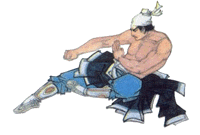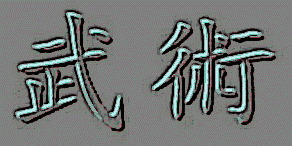

| Huang Baoshan | Xu Yun | Gao Zhankui | Guo Chengyou |
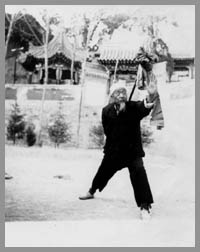
![]()
(1905-1998)
Born in the far town
of Tianshui ![]() ,
along the silk road, in the Gansu province, Huang Baoshan was a master
of the old Shaolin styles of boxing, the old weapons and expert of the
stick techniques of north west China.
,
along the silk road, in the Gansu province, Huang Baoshan was a master
of the old Shaolin styles of boxing, the old weapons and expert of the
stick techniques of north west China.
Tianshui, or
the 'town of the 'Water from the sky' was very important in the history
of the Chinese culture and civilisation. It is there that the first emperor
Fuxi, riding the Pegasus (Qiling) had writing down the sixty-four Bagua
![]() diagram.
diagram.
Tianshui was
also a way for the Buddhist monks to come in China trough the silk road
in the oasis of Gansu. The
But Gansu was
also a place where many nomad minorities came, and those terrible warriors
of the steppes where dangerous and able to fight riding on horses from
central Asia.
Gansu was a
region where many bloody battles fields had tacking place, and there is
a mixture between Chinese cultivated civilisation and the furious warrior
traditions of the steppes; As the proverb says:
'Gansu,
Wushu chu t'u
'The
military arts are growing from Gansu's earth'
In the all history
of China, many of those fighters got sedentary, lived in towns, learned
the Chinese culture, and formed the warrior caste of the earlier Chinese
emperors.
Growing up in
such a martial region, Huang Baoshan was a living treasury of the Chinese
culture, because he was carry on the old wushu tradition of the Chinese
warriors.
He started his
study of the martial arts from his youth with Master Mu Songlin ![]() .
.
Then, he continued
with the most famous teacher of north west China, great Master Sun Yanbiao
![]() (1884-1981),
a man who was travelling from place to place with a group of disciples.
Sun was earning his money by performing his wushu skills in public places.
He was also a marvellous fighter, participating to many duels with other
martial arts masters.
(1884-1981),
a man who was travelling from place to place with a group of disciples.
Sun was earning his money by performing his wushu skills in public places.
He was also a marvellous fighter, participating to many duels with other
martial arts masters.
Sun was also
the best expert of the old stick techniques of north-west China and his
fame became famous in the all China.
The famous proverb
says:
'Nanquan,
beitui
Dongqiang
xigun'
'Fists
in the south, legs in the north
Spears
in the east, sticks in the west'
Sun Yanbiao started
to have very famous students such as Wang Ziping ![]() (1881-1973),
and Wang Bugao 王步高 (1885-1960), also nicknamed 'Wang
the fighter' wangbashi.
(1881-1973),
and Wang Bugao 王步高 (1885-1960), also nicknamed 'Wang
the fighter' wangbashi.
The master
of Sun Yanbiao was a general of war named Shao Yinhuan ![]() (1862-1930)
the 'men with the silver hearing', living in the Mountains of the Dragon
(1862-1930)
the 'men with the silver hearing', living in the Mountains of the Dragon
![]() of Gansu.
of Gansu.
Shao Yinhuan
was a famous general in the tumultuous time of the warlords in China and
he has participated into many bloody wars.
Huang Baoshan
who was included then to this famous lineage of great Masters, started
to travel in China at the age of fifteen to find not only masters of martial
arts, but also Daoist and Buddhist philosophy teachers.
It is why he
has been in Henan province, to the Shaolin temple in 1920, at the time
the great Venerable abbot, master Miao Xin ![]() (1876-1934) who was ruling the temple.
(1876-1934) who was ruling the temple.
There, the young
Huang mastered the traditional Shaolin forms and the Shaolin steps techniques.
He went also
in Xian, at the Buddhist temple of the sleeping dragon Xi'an wolongsi ![]() where he studied Buddhist sutras and the ' Chan (zen) cane of the nine
rings' jiuhuanchazhang
where he studied Buddhist sutras and the ' Chan (zen) cane of the nine
rings' jiuhuanchazhang ![]() with
the Venerable abbot of the temple, the great Master Ranzhao
with
the Venerable abbot of the temple, the great Master Ranzhao ![]() .
.
Master Huang
Baoshan has not only carry on in the modern times of China the traditional
Chinese martial arts, but also the culture of the ancient, that has been
lost in many places because of the cultural-revolution.
I visited master
Huang in the summer 1993, at the age of nineteen in his town of Tianshui
from the far provinceof Gansu, along the silk road.
The Master received
me in his family, and teach me some of his knowledge.
The authorities
hasn't do anything for him and the treasure he was carry on, so he was
living in a poor house with no electricity built with dry earth.
Thanks to his
teaching, I could study later, in 2001 with his closest student, Master
He Tianfu ![]() ,
a fermer of ta village close to Tianshui town.
,
a fermer of ta village close to Tianshui town.
Here above,
I introduce his forms, with historical and technical details.
Erlu Hongquan:
The Red fist
in two parts ![]()
Huang Baoshan represents
the third generation of this form. He learned it in the Shandong province,
the birthplace of this style.
Hong Quan mouvements
are long and clear-cut. They are elegant and clear in the steps and the
application. This style is very similar of the long-range boxing (Chang
quan) of north China and it is a very classical and wild practised method
of Chinese Boxing.
This form has
many kicks from the back as a particularity and it requires agility and
speed as well of strength.
In the red fist
history, it is said that Zhao Kuanyi, the firs emperor of the Song Dynasty
had created it; But the real time for the systematisation of the style
is most probably recorded in the Qing Dynasty (1368-1911).
At the 13 year
of the Kangxi emperor reign (1674), the red fist has been created between
the provinces of Shandong and Shanxi.
There is also
another Hong Quan, called the Hong family boxing ![]() ,
but it is different, coming from the Guandong
,
but it is different, coming from the Guandong
Many Masters
has been known in this boxing style, such as Chang Jinwen, Zhang Zhen,
Guan Shuqing etc. But the three famous fighter where in the Daoguang Reign
(1821-1851); Gaosan 'the hawk', Xin san 'the black tiger', et Su San 'the
hungry tiger'.
The Red Fist
system then started to be famous in the anti-mandchou secret societies,
then it spread in the provinces of Henan, Sichuan and Gansu.
Master Huang
Baoshan was also an expert of the Great Red Fist Dahong quan.
There are about
thirty forms of the red fist and it is a very well known and spread classical
style of martial art in China.
Shaolin Zuibaxian
quan:
The fist of
the eight drunken immortals of Shaolin ![]()
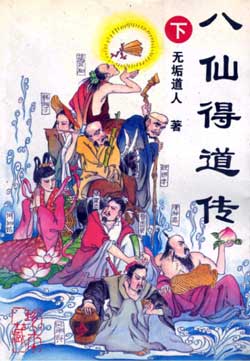
This wonderful and
long form of fist has been transmitted to Master Huang Baoshan from the
Shaolin
Well known from the movie of Jackie Chan (Chen long), 'the Drunken Master'
(Zui Quan), it represents the Daoist legend of the 'eight immortals crossing
the sea' Baxianguo hai.
Han Zhongli, Lu Dongbin, Lan Caihe, Cao Guojiu, He Xiangu (a women), Han
Xianzi, Zhang Guolao, and Tie Guaili are represented in various positions
according to the legend, after having been drunk, everyone of them having
his speciality.
For example , Tie Guaili was disable with the leg, Zhang Guolao could
disappear, Han Xianzi could play the flute etc.
This style has been popular at the end of the the Ming Dynasty (1368-1644)
but this is in 1784 in the Qing Dynasty that two masters, named Cao Huando
and Zhang Kongzhao has been arranged the system.
This system has been kept at the Shaolin temple and it was on of the subject
the warriors monks had to study.
The form Shaolin zuibaxian is an excellent exercise of Wushu using
a particularity of working keeping balance, changing directions and strength
in the legs muscles.
It use the positions and the fist techniques of the various Boxing of
the Shaolin temple, such as horse step (ma bu), bow step (gong bu),
'T' step (ding bu), and 'rest' step (xie bu).
His principal hand technique is the 'drinking hand' (bazi shou),
the palm (zhang), the hook (gou) and the fist (Quan).
This style use the techniques of the Shaolin temple with the attitude
of the drunken, but unlike modern performances routines of drunk style,
the traditional Shaolin eight drunk immortal boxing is very rich in techniques
and elegant in his application.
They are some falls in it, but they never hurt badly the body of the performer.
The rhythms are always changing, fast and slow, in a very relax way, as
the directions of hitting with fists and legs are very specific. In the
performance, the eyes are half closed and the look has to be as a drunk
in the state of mind, but not in reality.
The basic way of fighting in this style is Yi shou wei gong, gong
ji yi shou, or the way to use opponent's difficulty or ones block
to strike in a non-waited point and direction.
This Shaolin form is separated in height different section corresponded
to height different immortals, all the form need about five minutes to
be completed.
Luda Zuigun :
The stick
of Luda, the drunken Monk ![]()
The marvellous stick
form of Luda, the drunken Monk has been transmitted in the town of Lanzhou,
in Gansu province by a warrior monk of the Qing Dynasty (1644-1911), named
Tian Guanren.
This form has
many different techniques, and it is based on a four doors scale diagram
(simen) for the steps, (like most of the Gansu traditional cudgel forms).
Luda Zuigun
has been created after Lu Da (of the famous Chinese classic shuihu)
who became a Buddhist Monk in Wutai Shan in the Song Dynasty (960-1279),
after he escaped is town because he killed somebody.
His name became
Lu Zhishen, Lu the Great Wise soul, but in fact he was very big brutal
and stupid. In the
The form has
been made according to this legend , and it use the imitation of Lu Da's
attitudes and rough moves of the cudgel. The movements are big and expression
is the one of drunk men.
This system
of stick is very good and subtle for fighting and like the Shaolin Zuibaxian,
it has been kept well in secret.
Master Huang
Baoshan performed in 1958 with this form at the first national Wushu championship
at the capital Beijing.
The nine rings
Chan (Zen) cane
(Jiuhuan
Chanzhang) ![]()
The nine rings Chan
(Zen) cane is a well-known Buddhist weapon transmitted from the travelling
monks along the silk road.
It is composed
of a nine rings top and a spear head like talon. It was before known as
Khakkara in central Asia and it travelled along with the warrior monks.
The bonze could
defend himself with the spherical top, giving heavy blows and striking
the armours or breaking the lames. With the spear-talon, he could manage
to kill if necessary by using it as a spear.
The nine rings
Chan cane was also a ceremony instrument, used to perform dances of Dizang
(Kshitigarbha) the Buddha of the hell saving the souls. During the ceremony,
the monk was braking vases like he was getting the souls free of hell.
In the beginning,
the Khakkara had six rings of iron, symbolising the six ways of the life
(paramitas, liupolomi) of the Buddhist monk. The Buddha himself was supposed
to have twelve rings, but in china it became later on nine rings.
In the Tang
Dynasty (618-907), the Jiuhuan Chanzhang was one of the eighteen objects
that the Buddhist monk had to have on him.
The cane was
also used to lock on the door fortress when he was travelling, and the
sound of the rings could indicate that a monk was looking for refuge.
This weapon
is almost lost in China and very few people still know it.
It is a chance
that the young Master Huang could study in 1920 at the age of fifteen
with the venerable Ranzhao ![]() in
the 'Temple of the Sleeping Dragon' at Xian (
in
the 'Temple of the Sleeping Dragon' at Xian (![]() ).
).
Thanks to the
living history of this form that had survived until today trough the ages.
Laoren Kantiangun:
The stick of
the old men guarding the field ![]()
This famous form of
cudgel, is a very effective fighting method of the town Lanzhou, in the
Gansu province.
It has been
transmitted from the general Shao Yinhuan to his respective disciples
like Sun Yanbiao and Wang Bugao.
Laoren kantiangun
imitate an old men watching his field and chasing out the wild animals.
This stick method looking for long movements around and piercing techniques
with the cudgel's head. It changes very fast in the directions and never
strike where you are looking for. When it attacks, this cudgel turns around
like a bloody wind, and it chased the opponents face, head, or nee.
This famous
stick form is today only known in Gansu, with the name Gun Yangun or Laohan
kantiangun (the old Han watching the field).
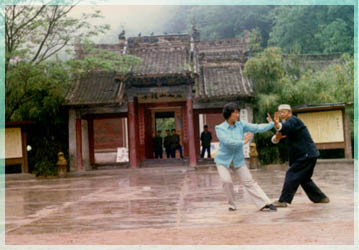
Master Huang Baoshan knew eighty-four forms... I introduce above some of them:
-Shaolin
Mizong Quan (fist of the lost trace from Shaolin)
-Shaolin Damo Quan (fist of Boddhidarma from Shaolin)
-Shaolin Jinggang Quan (fist of the Vajras from Shaolin)
-Shaolin Luohanquan (fist of the Arhats from Shaolin)
-Dahong quan (Big Red fist)
-Fenshou (separated hands)
-Bagua zhang (eight trigrams palm)
-Tanglang quan
(praying mantis fist)
-Simen gun (four
doors cudgel)
-Wuhu Biangan
(five tigers canes)
-Meihua biangan
(meihua cane)
-Ba san quan
(eight-four fist)
-Baxian gun
(eight immortals cudgel)
-Baxian jian
(eight immortals sword)
-Shuang jian
(two spears)
-Baishe Tiaozi
(white snake stuff)
-Meihua tiaozi
(meihua stuff)
-Moshou paizi
-Pai kou tiaozi
-Da qiang (big
spear)
-Sanjiegun
-Liuxin qui
etc.
Lucas Christopoulos, disciple of Huang Baoshan.
Switzerland, the 28 of August 2002.
